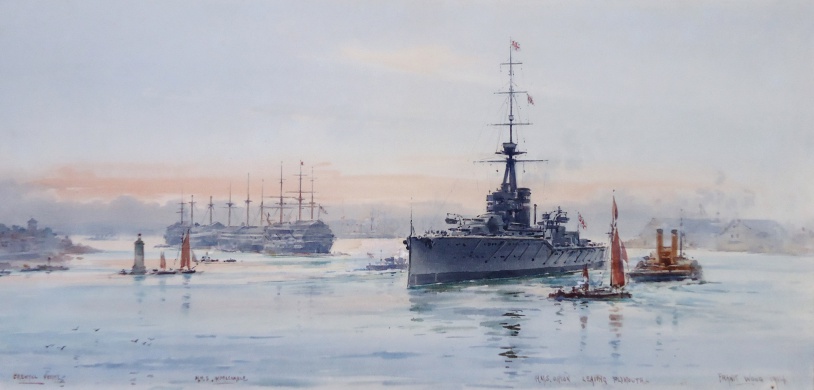Battle of Jutland veteran: the Grand Fleet battleship HMS ORION leaving Plymouth, 1914
. Frank Watson Wood (1862-1953). Watercolour signed and dated 1914 and annotated HMS Orion leaving Plymouth.
25 x 9 ins (63.5 x 22.8 cms) approx
POA
This original has been sold and is no longer available.
Prints of this may be available on: Maritime Prints.
Under the command of Captain F C Dreyer RN and wearing the flag of Rear Admiral Sir Robert Arbuthnot Bt MVO, HMS ORION had re-commissioned on 28th October 1913 and we see her here as she starts the long sinuous passage from the dockyard of Devonport down the Hamoaze and into the Sound. Visible close under the battleship's starboard bow is the stern of what looks like a torpedo boat destroyer who is clearly trying to nip into harbour and get alongside before the light goes: brave captain bringing his ship that close to the martinet Admiral Arbuthnot!
Just ahead of ORION's starboard beam is the Cremyll ferry and then Mount Edgecumb: after a short run to the south she will then be turning hard to port around the Vanguard Bank and with Mount Edgecumb now astern she will then run up on a north easterly heading through the Narrows and past Drake Island and The Hoe. Finally a turn to starboard - to take her through either Asia or Smeeton Pass - and thence she will gain Plymouth Sound and the open sea.
The watercolour is dated on the back “summer 1914” and so this could possibly be ORION’s last departure from her homeport before the country went to war in August for ORION was present at the great Fleet Review off Spithead on 19th July 1914. From there she proceeded to Portland where the First Fleet was held - with the flotillas and squadrons spilling over into Weymouth Bay too - in readiness for several days pending clarification of the worsening international situation. From here the ships were sailed in great secrecy on 29th July by the First Lord of the Admiralty, Winston Churchill, for the misty wastes of the north to ensure that there was no pre-emptive strike at Portland by the German fleet in those anxious hours before Great Britain committed to war. And so ORION and her fellow dreadnought battleships – now part of the newly named Grand Fleet – took up residence at Scapa Flow in the Orkney Islands where she and they was to be based for the next four long years.
Her Captain, Frederick Dreyer, was to become well known for his invention of the Dreyer fire control system with which many capital ships were fitted for central fire control; and for his non preferment as Commander-in-Chief of one of the main British Fleets in the early 1930s when all the indicators were that he was indeed destined for one of those two prizes, Atlantic or Mediterranean Fleet. But he was tarred with having been a too inactive member of the Admiralty Board in the events leading up to the Invergordon Mutiny in 1931 and he critically lost the confidence, we are told, of his seniors. It was therefore to the China Station as C-in-C that he was sent in 1933 and from there that he retired as a full admiral in 1936. He performed helpful and useful work during WW2 and died in 1956. His admiral in ORION in this painting, Sir Robert Arbuthnot, was to die gallantly at Jutland two years after the watercolour is dated when leading his armoured cruiser squadron in a characteristically brave but suicidal attack against the German Fleet. HMS ORION had a typically busy and hard worked Great War, paid off in 1922 and was scrapped in 1924, one of many relatively young battleships sacrificed to the stringencies of the Washington Treaty and of a drastically reduced naval vote. No longer could the Royal Navy continue to support the huge manpower bill, a legacy of the war years and which had been necessary to man the world's largest fleet - and so deep cuts in the fleet were inevitable.
